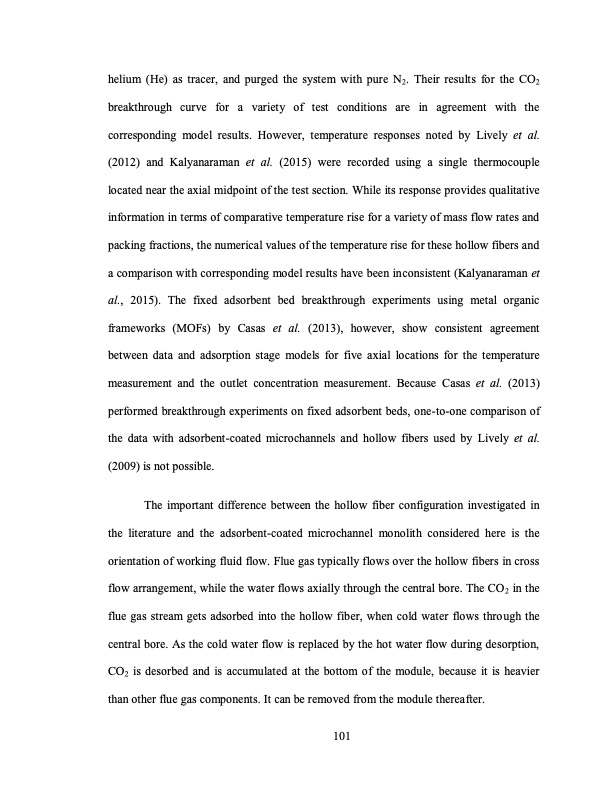
PDF Publication Title:
Text from PDF Page: 128
helium (He) as tracer, and purged the system with pure N2. Their results for the CO2 breakthrough curve for a variety of test conditions are in agreement with the corresponding model results. However, temperature responses noted by Lively et al. (2012) and Kalyanaraman et al. (2015) were recorded using a single thermocouple located near the axial midpoint of the test section. While its response provides qualitative information in terms of comparative temperature rise for a variety of mass flow rates and packing fractions, the numerical values of the temperature rise for these hollow fibers and a comparison with corresponding model results have been inconsistent (Kalyanaraman et al., 2015). The fixed adsorbent bed breakthrough experiments using metal organic frameworks (MOFs) by Casas et al. (2013), however, show consistent agreement between data and adsorption stage models for five axial locations for the temperature measurement and the outlet concentration measurement. Because Casas et al. (2013) performed breakthrough experiments on fixed adsorbent beds, one-to-one comparison of the data with adsorbent-coated microchannels and hollow fibers used by Lively et al. (2009) is not possible. The important difference between the hollow fiber configuration investigated in the literature and the adsorbent-coated microchannel monolith considered here is the orientation of working fluid flow. Flue gas typically flows over the hollow fibers in cross flow arrangement, while the water flows axially through the central bore. The CO2 in the flue gas stream gets adsorbed into the hollow fiber, when cold water flows through the central bore. As the cold water flow is replaced by the hot water flow during desorption, CO2 is desorbed and is accumulated at the bottom of the module, because it is heavier than other flue gas components. It can be removed from the module thereafter. 101PDF Image | TEMPERATURE SWING ADSORPTION PROCESSES FOR GAS SEPARATION

PDF Search Title:
TEMPERATURE SWING ADSORPTION PROCESSES FOR GAS SEPARATIONOriginal File Name Searched:
PAHINKAR-DISSERTATION-2016.pdfDIY PDF Search: Google It | Yahoo | Bing
CO2 Organic Rankine Cycle Experimenter Platform The supercritical CO2 phase change system is both a heat pump and organic rankine cycle which can be used for those purposes and as a supercritical extractor for advanced subcritical and supercritical extraction technology. Uses include producing nanoparticles, precious metal CO2 extraction, lithium battery recycling, and other applications... More Info
Heat Pumps CO2 ORC Heat Pump System Platform More Info
| CONTACT TEL: 608-238-6001 Email: greg@infinityturbine.com | RSS | AMP |